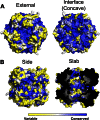The structure of CcmP, a tandem bacterial microcompartment domain protein from the β-carboxysome, forms a subcompartment within a microcompartment
- PMID: 23572529
- PMCID: PMC3668761
- DOI: 10.1074/jbc.M113.456897
The structure of CcmP, a tandem bacterial microcompartment domain protein from the β-carboxysome, forms a subcompartment within a microcompartment
Abstract
The carboxysome is a bacterial organelle found in all cyanobacteria; it encapsulates CO2 fixation enzymes within a protein shell. The most abundant carboxysome shell protein contains a single bacterial microcompartment (BMC) domain. We present in vivo evidence that a hypothetical protein (dubbed CcmP) encoded in all β-cyanobacterial genomes is part of the carboxysome. We show that CcmP is a tandem BMC domain protein, the first to be structurally characterized from a β-carboxysome. CcmP forms a dimer of tightly stacked trimers, resulting in a nanocompartment-containing shell protein that may weakly bind 3-phosphoglycerate, the product of CO2 fixation. The trimers have a large central pore through which metabolites presumably pass into the carboxysome. Conserved residues surrounding the pore have alternate side-chain conformations suggesting that it can be open or closed. Furthermore, CcmP and its orthologs in α-cyanobacterial genomes form a distinct clade of shell proteins. Members of this subgroup are also found in numerous heterotrophic BMC-associated gene clusters encoding functionally diverse bacterial organelles, suggesting that the potential to form a nanocompartment within a microcompartment shell is widespread. Given that carboxysomes and architecturally related bacterial organelles are the subject of intense interest for applications in synthetic biology/metabolic engineering, our results describe a new type of building block with which to functionalize BMC shells.
Keywords: CO2 Fixation; Carbon Dioxide; Carboxysome; Cell Compartmentation; Microbiology; Microcompartment; Protein Self-assembly; Protein Structure.
Figures





References
-
- Tanaka S., Kerfeld C. A., Sawaya M. R., Cai F., Heinhorst S., Cannon G. C., Yeates T. O. (2008) Atomic-level models of the bacterial carboxysome shell. Science 319, 1083–1086 - PubMed
-
- Kerfeld C. A., Sawaya M. R., Tanaka S., Nguyen C. V., Phillips M., Beeby M., Yeates T. O. (2005) Protein structures forming the shell of primitive bacterial organelles. Science 309, 936–938 - PubMed
-
- Tsai Y., Sawaya M. R., Yeates T. O. (2009) Analysis of lattice-translocation disorder in the layered hexagonal structure of carboxysome shell protein CsoS1C. Acta Crystallogr. D Biol. Crystallogr. 65, 980–988 - PubMed
Publication types
MeSH terms
Substances
Associated data
- Actions
- Actions
LinkOut - more resources
Full Text Sources
Other Literature Sources
Molecular Biology Databases

